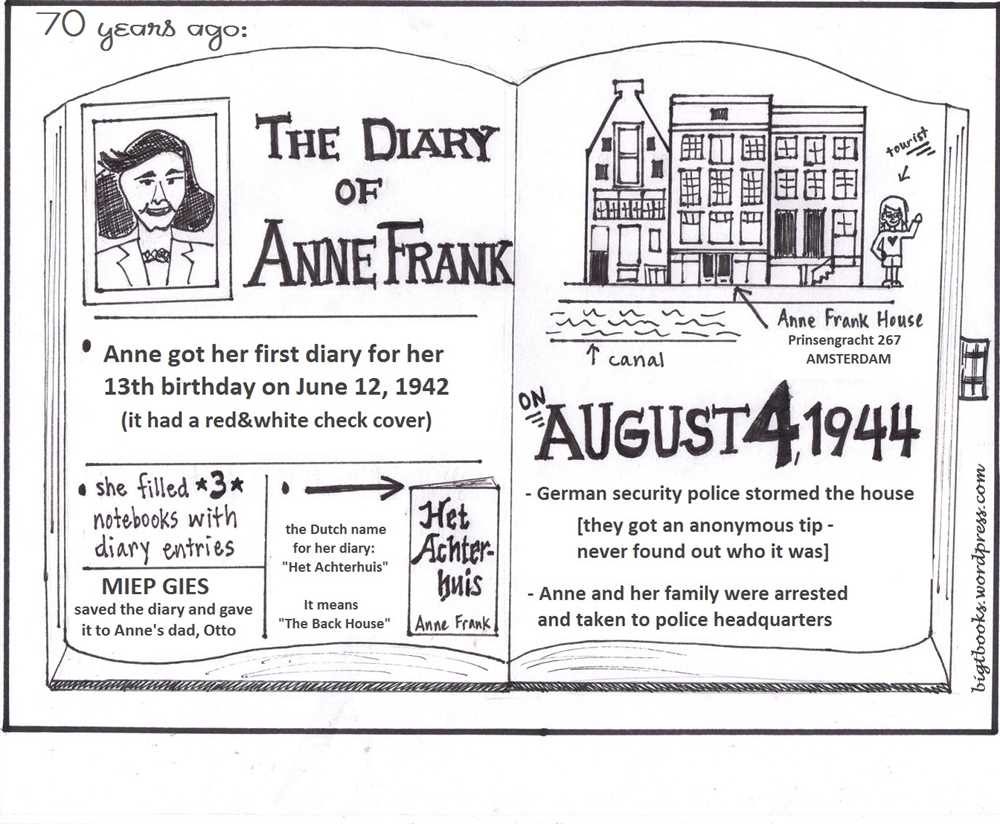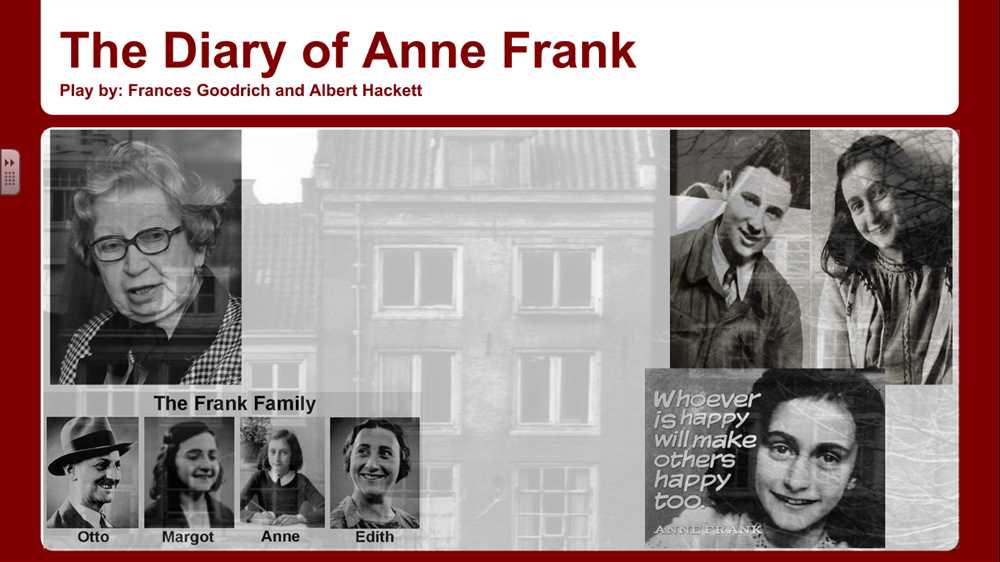
As one of the most powerful and poignant works of literature from the Holocaust era, “The Diary of Anne Frank” continues to captivate readers with its vivid portrayal of a young girl’s experiences hiding from the Nazis. In Act 1, we are introduced to the characters and conflicts that shape the story, setting the stage for the emotional journey that lies ahead.
The first act of the play presents us with a range of thought-provoking questions. One of the main questions that arises is how to maintain a sense of normalcy in the midst of such extreme circumstances. Anne and her family are forced to hide in a cramped secret annex, and it becomes increasingly challenging for them to preserve their humanity and sanity without any contact with the outside world.
Another significant question raised in Act 1 is the nature of human resilience and the will to survive. Despite the constant danger and fear they face, Anne, her family, and the other inhabitants of the annex find moments of joy, love, and hope amidst the darkness. This raises the question of what keeps people going in times of immense hardship and oppression.
Furthermore, Act 1 introduces us to the themes of identity and self-discovery. Anne, on the cusp of adolescence, grapples with her own identity and strives to find her voice. Through her diary entries, she explores her dreams, fears, and aspirations, providing us with an intimate window into the inner thoughts of a young girl coming of age under extraordinary circumstances.
Overall, Act 1 of “The Diary of Anne Frank” raises profound questions about humanity, resilience, and the struggle for identity in the face of adversity. It lays the foundation for the rich and complex narrative that unfolds throughout the play, inviting readers to reflect on the universal themes that continue to resonate today.
The Diary of Anne Frank Act 1 Questions and Answers

The Diary of Anne Frank Act 1 is the first part of the play that recounts the true story of Anne Frank, a Jewish teenager who had to hide with her family in an attic in Amsterdam during the Nazi occupation of the Netherlands. This act introduces the characters and sets the stage for the unfolding of the story. Here are some frequently asked questions and their answers for Act 1.
1. Who are the main characters introduced in Act 1?
- Anne Frank: The protagonist and the writer of the diary. She is a lively and talkative girl who is curious about the world.
- Margot Frank: Anne’s older sister, who is more reserved and mature.
- Mrs. Frank: Anne and Margot’s mother, who tries to keep the family together with her father.
- Margaret (Miep) Gies: A Dutch woman who helps the Frank family by bringing them food and supplies.
- Peter Van Daan: A teenage boy who is also in hiding with his family in the same attic as the Franks. Anne forms a connection with him.
- Mr. Frank: Anne and Margot’s father, who is the head of the family and tries to keep everyone calm and hopeful.
- Mr. Van Daan: Peter’s father, who is sometimes at odds with Mr. Frank.
- Mr. Dussel: A dentist who joins the Franks and the Van Daans in the attic, creating more tensions and challenges.
2. What is the setting of Act 1?
The setting of Act 1 is the attic of a building in Amsterdam, where the Frank family and the Van Daan family are in hiding to avoid being captured by the Nazis. The attic is cramped, dark, and shared among the eight people, which creates a tense and challenging living situation.
3. What are some key events that occur in Act 1?
- The families move into the attic and establish their new living arrangements.
- Anne starts writing her diary and shares her thoughts and feelings.
- The relationships between the different characters begin to develop and unfold.
- Anne and Peter form a friendship and spend time together.
- The families face the challenges of living in hiding, including limited food and the fear of being discovered.
4. What are some themes explored in Act 1?
Some themes explored in Act 1 include the fear and challenges of living in hiding, the importance of family and relationships, hope and resilience in the face of adversity, and the loss of freedom and normalcy due to war and persecution.
5. What do we learn about Anne Frank in Act 1?
In Act 1, we learn that Anne is a lively and talkative girl who is curious about the world. She loves writing and dreams of becoming a famous writer one day. She also struggles with the challenges of living in the confined and stressful attic, but she finds solace in her diary.
In the play “The Diary of Anne Frank,” Act 1 introduces the audience to the characters and sets the stage for the events that will unfold. The act begins with the Frank family, consisting of Mr. and Mrs. Frank and their two daughters, Anne and Margot, going into hiding in the annex of a building in Amsterdam to escape the persecution of Jews during World War II. They are accompanied by another family, the Van Daans, and a dentist named Mr. Dussel.
Throughout Act 1, the audience gets to know the characters and their dynamic within the confined space of the annex. Anne, who is thirteen years old, immediately establishes herself as a lively and talkative girl who dreams of becoming a famous writer one day. She is eager to document their experience in hiding and starts writing a diary, which becomes a central element of the play.
The relationships between the characters are complex and sometimes strained, as they are forced to live in close quarters for an indefinite period of time. Mrs. Frank plays the role of a peacemaker, trying to maintain harmony among the residents of the annex. Mr. Van Daan is portrayed as opportunistic and self-serving, while his wife, Mrs. Van Daan, is more sympathetic and caring. Mr. Dussel, who joins the annex later on, adds to the tension with his strict and grumpy demeanor.
This act also introduces Miep Gies and Mr. Kraler, two Dutch citizens who help the families by bringing them food and supplies and keeping their secret. Their presence shows the bravery and compassion of the Dutch people who risked their own lives to protect Jews during the war.
The Setting of Act 1
The setting of Act 1 in “The Diary of Anne Frank” is in Amsterdam, the Netherlands, during the time period of World War II. The play opens in July 1942 and continues until August 1944. Specifically, the majority of the events take place in the secret annex, a hidden room located behind a bookcase in Otto Frank’s office building.
The secret annex: The secret annex serves as the main setting for the play, where the Frank family and four others go into hiding to escape the persecution of Jews under Nazi rule. It is a cramped space with limited ventilation and natural light, making it necessary for the inhabitants to remain quiet and discreet. The annex is divided into several rooms, including a common area, bedrooms, and a bathroom.
- The common area: This is the central space in the secret annex where the inhabitants gather for meals, discussions, and other activities. It is where Anne writes in her diary and where most of the interactions and conflicts between the characters occur.
- The bedrooms: Anne and her sister Margot share a bedroom, while Mr. and Mrs. Van Daan have their own separate room. Peter, the Van Daan’s son, occupies a small attic space.
- The bathroom: The bathroom in the secret annex is equipped with a sink and a small toilet. Since it needs to be shared by all the inhabitants, it becomes a source of tension and inconvenience.
Throughout Act 1, the setting creates a sense of confinement, isolation, and constant fear among the characters as they struggle to survive in hiding. The small and claustrophobic space amplifies the emotional and physical challenges they face, while also highlighting the strength and resilience they demonstrate in coping with their situation.
Main Characters in Act 1

In Act 1 of “The Diary of Anne Frank,” there are several main characters who play significant roles in the story. The play revolves around the experiences of Anne Frank and her family, who are hiding from the Nazis during World War II in an attic in Amsterdam.
Anne Frank: Anne is the main protagonist of the play and the writer of the diary that serves as the basis for the story. She is a thirteen-year-old Jewish girl who is optimistic, curious, and often clashes with her mother. Through her diary entries, Anne shares her thoughts, fears, and hopes as she navigates the challenges of living in hiding.
Mr. Frank: Mr. Frank, also known as Otto Frank, is Anne’s father. He is a kind and patient man who takes on the role of the family’s leader in the attic. As a successful businessman before the war, Mr. Frank provides guidance and stability for the other occupants of the secret annex.
Mrs. Frank: Mrs. Frank, also known as Edith Frank, is Anne’s mother. She is more reserved and traditional than Anne and often struggles to connect with her daughter. Despite her disagreements with Anne, Mrs. Frank cares deeply for her family and does her best to keep everyone safe.
Margot Frank: Margot is Anne’s older sister. She is quieter and more reserved than Anne but shares a close bond with her. Margot is often seen as the more mature and responsible sibling and serves as a source of comfort and support for Anne.
Miep Gies: Miep is one of the Dutch workers who helps the Franks and the Van Daans while they are in hiding. She provides them with food, news from the outside world, and emotional support. Miep’s kindness and bravery are instrumental in sustaining the hidden occupants throughout their time in the secret annex.
Mr. Van Daan: Mr. Van Daan, whose real name is Hermann Van Pels, is a business associate of Mr. Frank’s who joins the group in hiding. He is ambitious but also selfish and often clashes with the others in the confined space. Him and his wife have a tumultuous relationship that adds tension to the already challenging circumstances.
Mrs. Van Daan: Mrs. Van Daan, whose real name is Auguste Van Pels, is Mr. Van Daan’s wife. She is concerned with appearances and often argues with her husband. Mrs. Van Daan brings both comic relief and conflict to the play through her interactions with the other characters.
Peter Van Daan: Peter is the son of Mr. and Mrs. Van Daan and becomes a close friend of Anne’s during their time in hiding. He is shy and introverted but develops a deep connection with Anne. Peter’s growing friendship with Anne serves as a source of comfort and companionship for both of them during their difficult confinement.
Mr. Dussel: Mr. Dussel, whose real name is Fritz Pfeffer, is a dentist who joins the group in hiding later on. The addition of Mr. Dussel further strains the already cramped living conditions in the attic. He clashes with Anne and struggles to adapt to the challenges of life in hiding.
In addition to these main characters, there are other individuals and supporting characters who contribute to the story’s development and themes of survival, friendship, and the human spirit. Despite the difficult circumstances they face, each character plays a vital role in shaping the narrative and creating a sense of hope in the face of adversity.
What is the Conflict in Act 1?

The conflict in Act 1 of “The Diary of Anne Frank” revolves around the characters’ struggles to adjust to their new reality of living in hiding during the Holocaust. The main external conflict is their fear of being discovered by the Nazis and the constant threat of deportation to concentration camps. This fear creates tension and unease among the characters, as they must remain silent and hidden during the day and can only move and make noise at night.
Another conflict in Act 1 is the internal conflict faced by Anne Frank herself. She is a lively and talkative young girl who finds it difficult to confine herself to the small attic space and curtail her natural inclinations to be loud and expressive. This conflict between Anne’s desire for freedom and her need to remain hidden creates tension not only within herself but also with the other inhabitants of the annex.
Additionally, there is a conflict between the different personalities and temperaments of the characters in the annex. Some clash with each other due to their varying beliefs, values, and coping mechanisms. For example, Mr. Frank tries to maintain a positive outlook and keeps everyone unified, while Mrs. Van Daan often complains and creates tension within the group. These conflicts add to the overall drama and complexity of the play, highlighting the challenges and strains of living in close quarters under such dire circumstances.
- External conflict: Fear of being discovered by the Nazis
- Internal conflict: Anne’s struggle to adjust to life in hiding
- Conflict between different personalities in the annex
What Happens in Act 1?

The first act of “The Diary of Anne Frank” introduces us to the main characters and sets the stage for the events that will unfold. The story takes place in Amsterdam, Netherlands, during World War II, and follows the lives of the Frank family as they go into hiding to escape persecution by the Nazis.
The act begins with Mr. Frank, Anne’s father, preparing the secret annex where the family will live in hiding. The annex is hidden behind a bookcase in Mr. Frank’s office building. The family is joined by the Van Daan family, Mr. Van Daan, Mrs. Van Daan, and their son Peter, as well as Mr. Dussel, another Jewish man seeking refuge.
In the confined space of the annex, tensions quickly arise as the families struggle to adapt to their new living conditions. Anne, a lively and curious teenager, finds solace in her diary, which she receives as a birthday present. She confides her thoughts and fears to her diary, whom she affectionately names “Kitty.”
As time goes on, Anne’s relationship with her mother becomes strained, while she develops a close bond with her father and Peter. Arguments and conflicts arise as the families grapple with the challenges of living in such close quarters and the constant fear of being discovered by the Nazis.
Throughout Act 1, the characters’ hopes and dreams are revealed, as well as their fears and anxieties. It becomes clear that the war has forced them into a difficult and dangerous situation from which there is no easy escape.